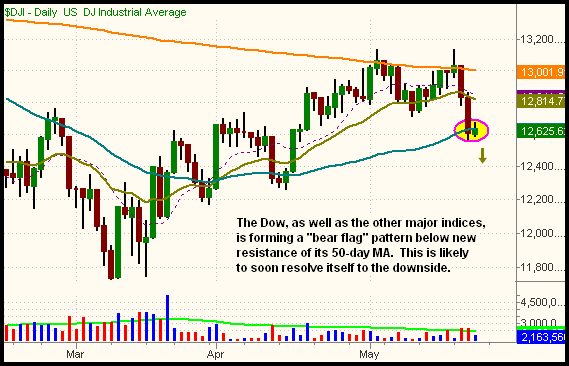| The Wagner Daily ETF Report For May 23 |
| By Deron Wagner |
Published
05/23/2008
|
Stocks
|
Unrated
|
|
|
|
The Wagner Daily ETF Report For May 23
After opening near unchanged levels, the major indices chopped around in a relatively tight, sideways range throughout the entire day. Stocks finished marginally higher, but still near their previous day's lows. The Dow Jones Industrial Average bounced 0.2%, S&P 500 0.3%, and the Nasdaq Composite 0.7%. Although the small-cap Russell 2000 advanced 0.8%, the S&P Midcap 400 showed relative weakness for a change, gaining just 0.3%. All the main stock market indexes closed near the middle of their narrow intraday ranges.
Total volume in the NYSE eased 13%, while volume in the Nasdaq similarly retreated 12% below the previous day's level. After Wednesday's active pummeling, it would have been more positive if higher volume accompanied yesterday's gains. Instead, the lower turnover told us institutions were unwilling to heavily deploy capital following the previous day's sell-off. Despite the slight gains in the S&P and Dow, advancing volume in the NYSE was roughly on par with declining volume. The more resilient Nasdaq adv/dec volume ratio was positive by 2 to 1.
If the bulls had hopes of stocks snapping back from their recent weakness going into yesterday morning, they were surely disappointed by day's end. Though all the major indices recovered a bit of ground, their gains were minor compared to the losses of the preceding two days. The result of yesterday's modest, low-volume bounce is that the main stock market indexes have begun to form "bear flag" patterns on their daily charts. This pattern occurs when stocks follow-up a significant sell-off by merely trading in a tight range, near the lows of the range of the sell-off. The patterns are similar on the charts of all the major indices, but the Dow is in the most precarious state because it's forming a "bear flag" right below new resistance of its 50-day MA. This is illustrated on the chart below:

With this type of pattern, the Dow Jones Industrial Average, as well as the other main stock market indexes, could continue to consolidate near its two-day low for another session or two. But if the index fails to recover at least 50% of the week's losses within the next one to two days, odds are good the Dow will break down below its May 21 low sometime next week. Remember that the longer an index consolidates near its low, the more downward momentum it will suffer when the eventual break of support occurs. We're already short the Dow, via the UltraShort Dow 30 ProShares (DXD), but a break of the May 21 low presents a relatively low-risk, alternative entry point if not already short the blue-chip index and are looking to do so.
Because the broad-based stock market indexes are clinging to support of their May 21 lows, it's unlikely traders will feel good about stepping in to aggressively buy ahead of the three-day holiday weekend. Conversely, selling pressure could be equally light, as traders frequently close up shop early ahead of holiday weekends. Regardless of today's level of trading activity, remember the market does not care what you, me, or anyone else thinks. Just as water running down a hill flows around obstacles without giving it a thought, the stock market always follows the path of least resistance. That's why our mantra is to "trade what you see, not what you think." Next week, we'll take a fresh, objective look at which ETFs are performing the best and worst in the new downward bias of the broad market. Until then, we'll just focus on managing existing positions.
Deron Wagner is the Founder and Head Trader of both Morpheus Capital LP, a U.S. hedge fund, and Morpheus Trading Group, a trader education firm launched in 2001 that provides daily technical analysis of the leading ETFs and stocks. For a free trial to the full version of The Wagner Daily or to learn about Wagner's other services, visit MorpheusTrading.com or send an e-mail to deron@morpheustrading.com.
|